wIRA Device certification
- MedicalDeviceDirective93/42/EEC
- EC certificate
- ISO certificate
- CE- Conformity Performance
- Six clinical studies, evidence level of Ia/Ib.
Technical Data
| Power cable | country-specific, IEC receptacle |
| Radiation emission | water filtered Infrared A (wIRA®: 780-1400nm), Visible light (400-780nm), contains no UV radiation |
| Irradiation field Nominal voltage Power | 20 cm/32 cm diameters230 V, 50 – 60 Hz alternating current
600 W/ 775 W country specific available |
| Consumption | Length: 28,5/28 cm, wide: 23,5/27 cm, height: 35,5/28 cm |
| Temperature protection | automatic resetting temperature after cooling |
| Dimensions Irradiance | E = 200 ±10% mW/cm2 ( in the center of the optical axis ) |
| Country of origin | Federal Republic of Germany |
Clinical information
Thermal Effects:
wIRA increases
- temperature
- oxygen partial pressure
- perfusion in the tissue
Non-thermal effects: putting direct stimuli on cells cellular structures
wIRA decreases
- pain (and required dose of analgesics)
- hypersecretion
- inflammation
wIRA can show
- positive immunomodulatory effects
Working mechanisms of wIRA
The experience of the pleasant heat of the sun in moderate climatic zones arises from the filtering of the heat radiation of the sun by water vapor in the Earth’s atmosphere, see Figure 1. The filter effect of water decreases those parts of infrared radiation (most parts of infrared-B and -C and the absorption bands of water within infrared-A), which would otherwise – by reacting with water molecules in the skin – cause an undesired thermal load to the surface of the skin.
Technically, water-filtered infrared-A (wIRA) is produced by special radiators, whose full spectrum of radiation of a halogen bulb is passed through a cuvette containing water, which absorbs or decreases the described undesired wavelengths of the infrared radiation, see Figure 2. Within the infrared range, the remaining wIRA (within 780–1400 nm) mainly consists of radiation with good tissue penetration properties and therefore allows – compared to unfiltered heat radiation – a multiplication of the energy transfer into tissue without irritating the skin, similar to the sun’s heat radiation in moderate climatic zones. Typical wIRA radiators emit no ultraviolet (UV) radiation and almost no infrared-B and -C radiation and the amount of infrared-A radiation in relation to the amount of visible light (380–780 nm) is accentuated, see Figure 3.
Within the spectra of infrared-A and water-filtered infrared-A, radiation effects in particular of the energy-rich wavelengths near to visible light – approximately 780–1000 nm (800–900 nm, 800 nm, 820 nm, 830 nm) – have been described both in vitro and in vivo. These wavelengths seem to represent the clinically most important part of the infrared-A and wIRA range.
Water-filtered infrared-A as a special form of heat radiation with a high tissue penetration and with a low thermal load to the skin surface (see Figure 4), acts both by thermal (related to heat energy transfer) and thermic (temperature dependent, with a relevant change of temperature) as well as by non-thermal (without a relevant transfer of heat energy) and non-thermic (not depending on temperature, without a relevant change of temperature) effects.
wIRA produces a therapeutically usable field of heat in the tissue and increases tissue temperature, tissue oxygen partial pressure, and tissue perfusion. These three factors are vital for a sufficient supply of tissue with energy and oxygen. As wound healing and infection defense (e.g. granulocyte function including its antibacterial oxygen radical formation) depend decisively on a sufficient supply of tissue with energy and oxygen and since the centers of chronic wounds are often relatively hypothermic (while e.g. both preoperative and postoperative heat supply to the operation field can improve healing of acute wounds) and frequently have an oxygen partial pressure close to zero, one explanation for the good clinical effect of wIRA on wounds and wound infections could be the improvement of both the energy supply per time (increase of metabolic rate) and the oxygen supply.
In addition, wIRA has non-thermal and non-thermic effects, which are based on a direct stimulation of cells and cellular structures: Reactions of cells to infrared radiation – partly found even at very small irradiances – are e.g. target-oriented growth of surface extensions (plasmodia), influence on cytochrome coxidase, target-oriented growth of neurons, stimulation of wound repair as well as cell protective effects of infrared-A and water-filtered infrared-A (wIRA).
wIRA can considerably alleviate pain (with remarkably less need for analgesics) and diminish an elevated wound exudation and inflammation and can show positive immunomodulatory effects. wIRA can advance wound healing or improve an impaired wound healing both in acute and in chronic wounds, including infected wounds. Even the normal wound healing process can be improved.
wIRA is contact-free, easily applied, involves no discomfort to the patient or the use of expendable materials and is effective even in deeper-lying tissue regions. wIRA application, with appropriate therapeutic irradiances and
doses, could be shown not only to be harmless for human skin, but even to have protective effects in cells against damage caused by UV radiation.
Safety aspects of the clinical use of wIRA have been described extensively, especially in the application of wIRA with adequate irradiances can be considered as being safe. The irradiation of the typically uncovered wound is carried out using a wIRA radiator, see Figure 5.
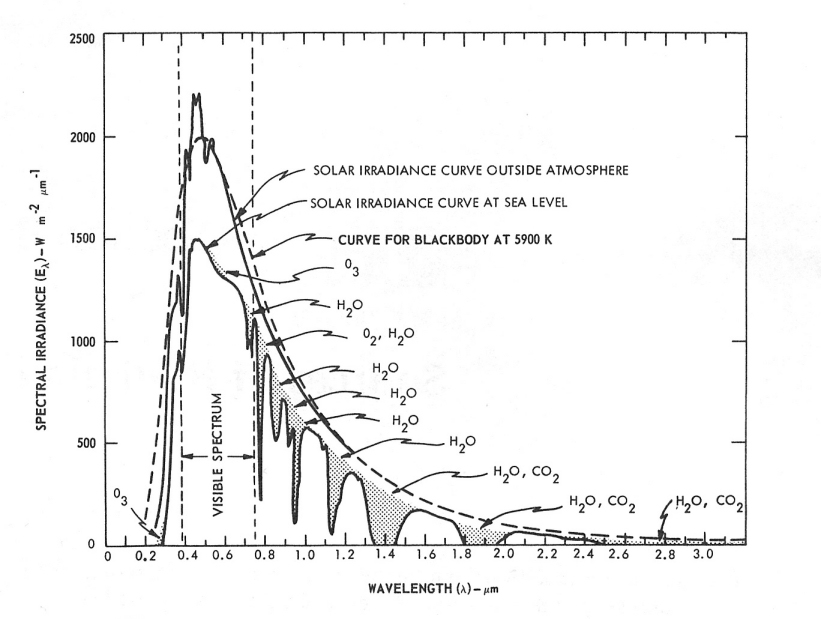
Figure 1: Spectral solar irradiance outside the atmosphere and on the surface of the Earth at sea level,
in both cases with the sun at the zenith and for a mean Earth-sun distance. Shaded areas indicate absorption before reaching
the surface of the Earth at sea level due to the atmospheric constituents shown.
For comparison of Figures 1 and 3: 1000 W · m–2 · µm–1 = 100 mW · cm–2 · µm–1 = 1 mW · cm–2 · (10 nm)–1
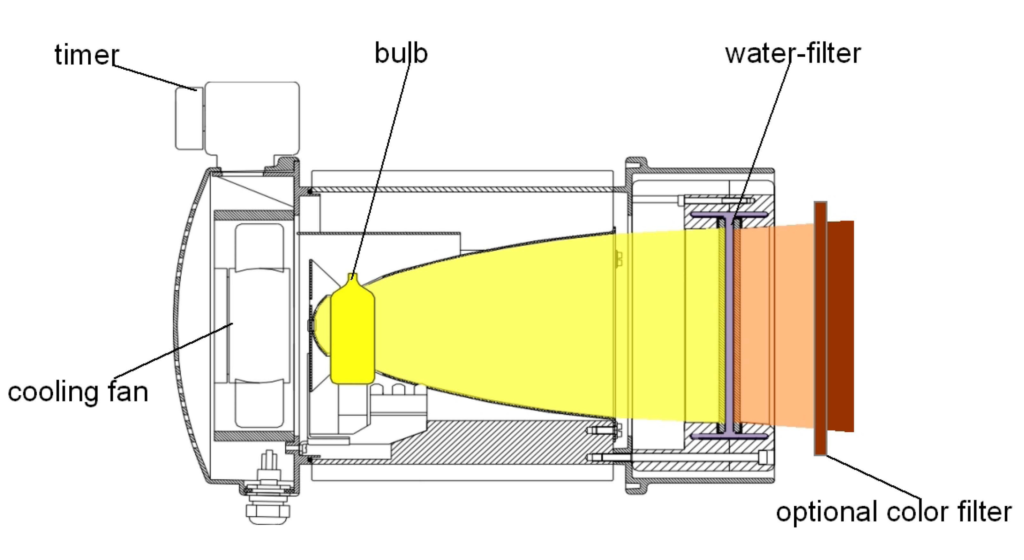
Figure 2: Cross-section of a water-filtered infrared-A radiator
The whole incoherent non-polarized broadband radiation of a 3000 Kelvin halogen bulb is passed through a cuvette containing
water, which absorbs or decreases the undesired wavelengths within the infrared region (most parts of infrared-B and -C and the
absorption bands of water within infrared-A). The water is hermetically sealed within the cuvette. A fan provides air cooling of the
cuvette to prevent the water from boiling.
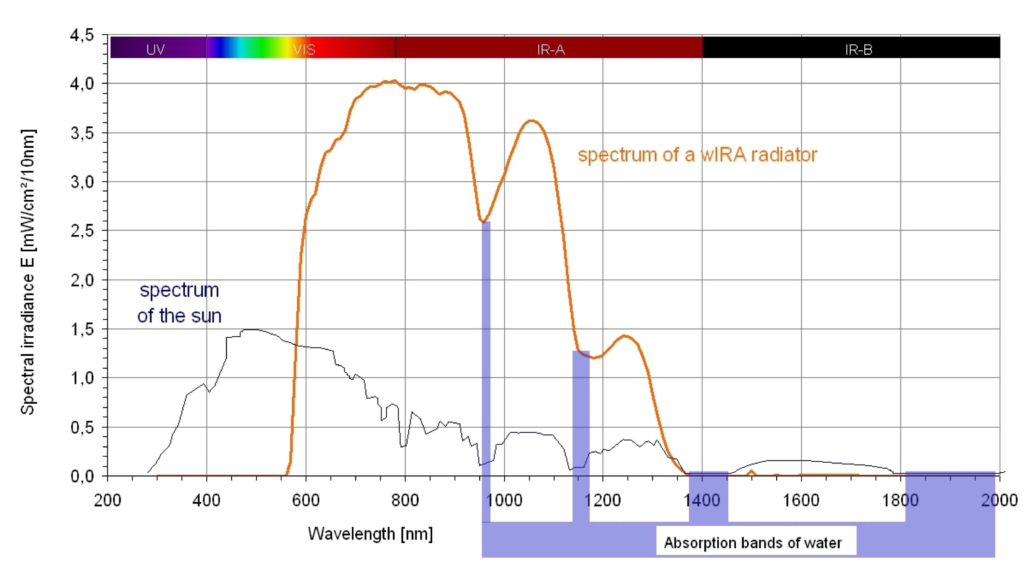
Figure 3: Comparison of the spectra of the sun on the surface of the Earth at sea level and of a water-filtered infrared-A radiator
Spectral solar irradiance on the surface of the Earth at sea level (with the sun at the zenith and for a mean Earth-sun distance) as in Fig. 1 (from [1], adapted from [58]) and spectral irradiance of a water-filtered infrared-A radiator (wIRA iradiator 500w with 10 mm water cuvette and orange filter OG590) at approximately 210 mW/cm² (= 2.1 · 10³ W/m²) total irradiance (from [1], [4]). The spectrum of the sun at sea level includes ultraviolet radiation (UV, <400 nm), visible light (VIS, 380–780 nm), and infrared radiation (IR, >780 nm). The spectrum of the water-filtered infrared-A radiator includes only visible light (VIS) and infrared radiation (IR); the visible part depends on the color filter used; the wIRA radiator does not emit ultraviolet radiation (UV). Both spectra show the decreased irradiances of the absorption bands of water.
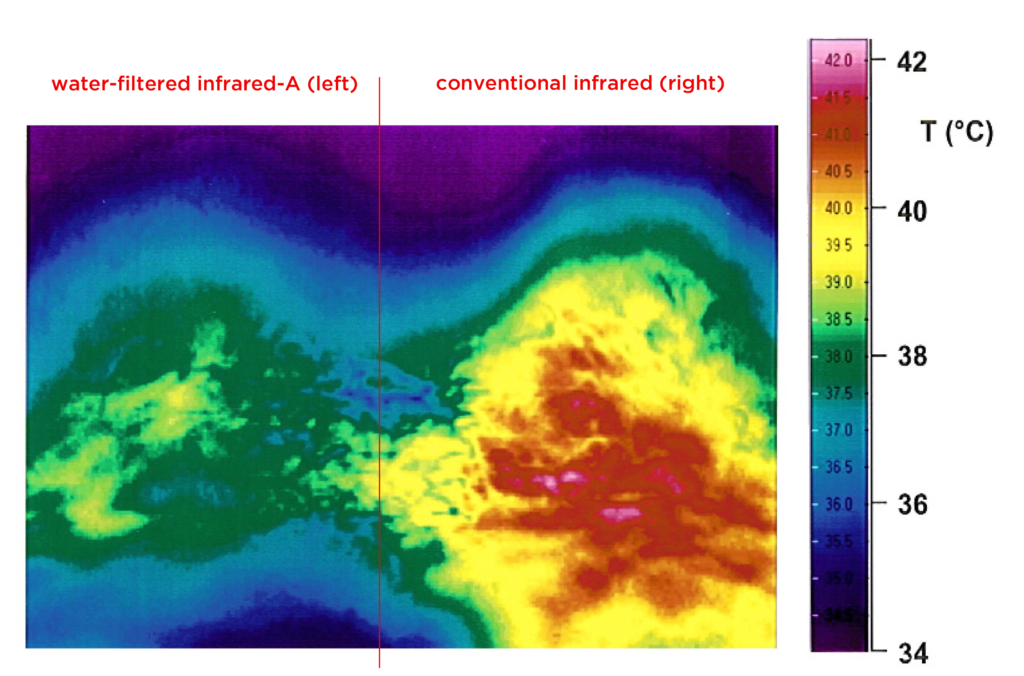
Figure 4: Comparison of irradiation with water-filtered infrared-A and with conventional infrared
Thermographical comparison of skin surface temperatures in the lumbar region 12 minutes after commencement of irradiation
with water-filtered infrared-A (left) and conventional infrared (right) with the same irradiance: the skin surface temperature is
higher in the case of irradiation with conventional infrared (presented in the thermography), while the temperature at 1 cm tissue
depth is higher when irradiating with water-filtered infrared-A. Water-filtered infrared-A thus leads to a high tissue
penetration combined with a low thermal load to the skin surface.
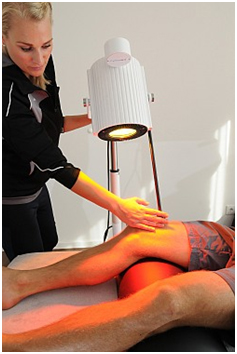
Figure 5: Example of an irradiation of a wound with a waterfiltered infrared-A radiator
Hoffmann G. Water-filtered infrared-A (wIRA) in acute and chronic wounds.
GMS Krankenhaushyg Interdiszip. 2009;4(2):Doc12.
DOI: 10.3205/dgkh000137